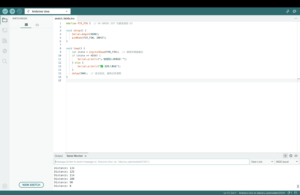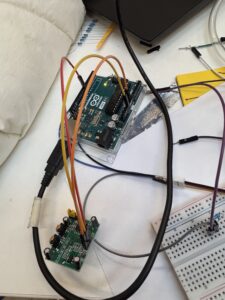I was responsible for the production portion of the final video, on-site documentation, as well as the interviews with the experiencers and the overall video wrap-up.

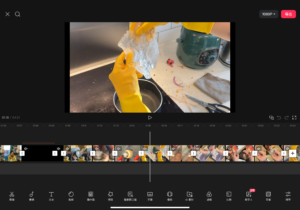


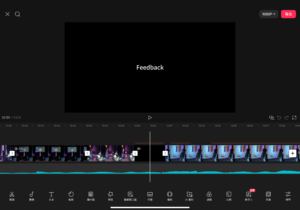
I was responsible for the production portion of the final video, on-site documentation, as well as the interviews with the experiencers and the overall video wrap-up.





Inspiration
Shape: In exploring the natural rhythms of respiration and in thinking deeply about breathing, our installation symbolizes the expansion and contraction of respiration through elements such as lungs and plants, embodying the close connection between respiration and emotion.
Meaning: We combined the physiological act of breathing with emotional expression, using lung-inspired forms to symbolize life and vitality. The lily shape represents the rhythm and continuity of breath, while also symbolizing forgiveness and release—echoing the calming effects of deep breathing.
Manufacturing Process
Flower Construction
Recycled plastic bottles were repurposed to create flower petals. The bottles were cut into thin sheets, trimmed into petal shapes, and heated using candles or a heat gun, allowing the edges to curl naturally. These sculptural petals were then attached to the branches using hot melt glue. A short stop-motion animation documented the process.
Lung Structure Shaping
A malleable resin material was used to form lung-like shapes. After boiling the resin to soften it, the forms were shaped by hand, with surface detailing to mimic the texture of human lung lobes. Four translucent lung structures were completed in this way.
Branch Construction
Multiple pieces of wire were twisted together to form organic, twig-like branches. These were shaped to resemble elements of the respiratory system. A thin layer of resin was applied to the surface to reduce the metallic look and better integrate with the rest of the installation. Small lights were placed at the base to represent flowing life energy.
Final Assembly
The resin lungs and plastic petals were gradually assembled onto the wire branches using hot melt glue. Together, the intertwined elements—lungs, flowers, and branches—create a cohesive installation that symbolically explores the rhythm of breath and the continuity of life.
Outcome
The installation gives a sense of stillness and relaxation, echoing the connection between the emotions and the body. In this way, the installation is not only a work of art, but also becomes a medium for meditation and relaxation.
Reflection
The main challenge was integrating lung structures with botanical elements. Wire branches required precise crafting for both stability and aesthetics. Petals made from melted plastic bottles were easier to shape, but the detailing could be improved. Overall, the result matched the original concept of expressing breath and life. Future iterations will explore more diverse materials for finer effects and greater interactivity.
Visual consistency: A key issue was the visual disconnect between the physical installation and the digital elements. Jules suggested importing photos of the sculpture into TouchDesigner and turning them into abstract visuals. This could unify the physical and digital, similar to the approach used in 77 Million Paintings.
Interviewee introduction:
On March 14, I interviewed Marvin, a friend of mine who took a meditation class with me in China and is now studying in Edinburgh. Here are highlights from our interview.
Key Themes:
Breath Awareness: Easier to notice breathing during meditation; the pandemic has had no impact on the Marvin’s breathing habits.
Breath & Emotion: Breathing patterns are closely related to emotions—steady breathing represents calmness, while rapid breathing occurs during stress or exercise.
Physical Sensation of Breathing: Deep breathing expands the chest cavity and makes airflow feel tighter, while shallow breathing is the natural state.
Visualization of Breathing: Feels like fog, with resistance, containing tiny airborne particles like dust and floral scents.
Color & Relaxation: White and green create a sense of relaxation, while black and neon colors induce tension.
Sound & Breathing: Environmental sounds can influence breathing rhythms, such as calming bookstore music versus fast-paced tracks that create tension.
Sound of Breathing: Preference for gentle music, such as vinyl records and blues.
Design Directions:
Visual Representation
Breathing pattern: Respondents compared breathing to ‘fog’, with fluidity and slight resistance, may use particle animation , cloud effect performance, we can use soft colors such as the white, the blue , and use gradient light effects to make the change of breathing more intuitive.
Sound Design
Use ambient sounds, low-frequency resonances, soft rhythms to stabilize breathing, and soft white noise or nature sounds to enhance immersion
Interaction Experience
Breathing Visualization Feedback: As the user adjusts their breathing, the on-screen breath visualization could become clearer or more diffuse.
Test equipment: Arduino temperature humidity sensor DHT11
Tester: Li Lyu, Can Huang
Technical Support: Joe Hathway
When testing the Temperature humidity sensor DHT11 for the first time, the serial monitor could not display temperature and humidity data. The initial check of the hardware connection is correct, and the problem is suspected in the use of code or libraries.
Troubleshooting & code modification
Huang Can and I asked Joe for help, and after checking the code, he found that the problem was the installation of the library and the code setup.
Joe pointed out that after we install the DHT library in Arduino, we need to call the DHT code correctly in the Tool. The sensor type in the code was originally set to DHT22, but we actually used DHT11, causing the data to not be read properly.
We will DHT dht(DHTPIN, DHT22); Change it to DHT dht(DHTPIN, DHT11). Make sure the code matches our sensor model.
After the code was modified, it was uploaded to Arduino again, and the serial port monitor successfully displayed temperature and humidity data, and the problem was solved.
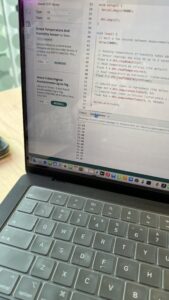
Test equipment: Arduino Grove sound sensor
Tester: Li Lyu
Test objectives:
1. Test the Grove sound sensor’s data detection response time and optimize its detection speed.
2. Evaluate the sound sensor’s ability to detect breath and sound to determine if it is suitable for subsequent installation interactions.
Test process & Results:The code runs successfully. The serial monitor can display the sound signal data and change with the environment sound.
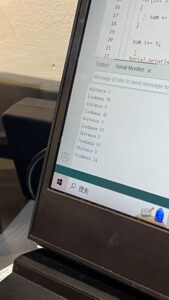
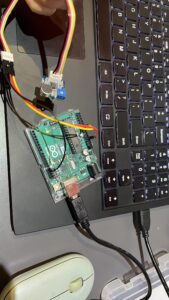
However, under the current test conditions, the response time of data detection is long and there is a certain delay.
The data fluctuates greatly due to background noise.
The testing for Ultrasonic sensor, Temperature and Humidity sensor and Arduino PIR Motion Sensor.
Li Lyu and Can Huang borrowed some sensors from the book it centre and conducted a series of tests based on the existing sensors. In addition, we summarized the list of required materials by analyzing the existing technologies of the project:
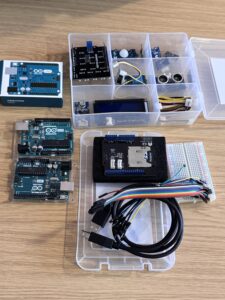
1. Ultrasonic sensor test
Tester: Can Huang, Li Lyu
Test time: 2/3
Test materials: Ultrasonic sensors
Test results: In this test, we successfully connected the ultrasonic sensor to the UNO board and uploaded the code through Arduino software. After inspection, the code runs smoothly, and the serial monitor successfully displays data changes, indicating that the sensor can work normally and feed back the measurement data in real time. The test results show that there are no obvious problems in hardware connection, code writing and data reading, and the feasibility of the system is preliminarily verified.
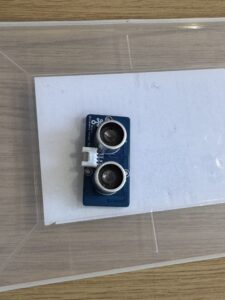
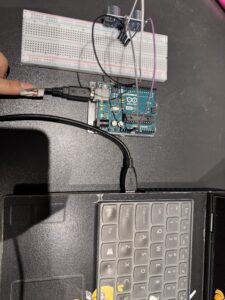
2. Temperature and Humidity sensor
Tester: Lu Li, Huang Can
Test time: 2/6
Test materials: Temperature and Humidity sensor,10K resistor, Uno board, bread board
Test result: In this test, DHT11 temperature and humidity sensor is connected to Arduino UNO board, and VCC(5V) and SIG(2) are connected in series through 10kΩ pull-up resistor.
1. The initial code could not run because the DHT11 sensor library was not installed. The problem was resolved after installation.
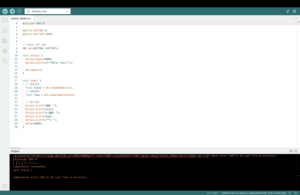
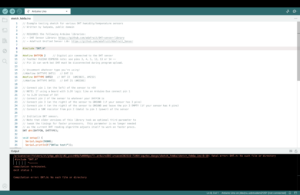
2. After the code is uploaded, it is found that an additional pull resistor is needed to ensure that the data is read successfully, and the code runs normally after the addition.
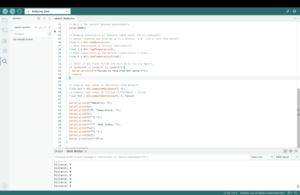
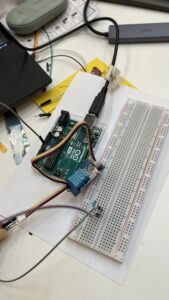
3. The serial monitor successfully obtained data, but only detected distance data, and the temperature data did not change.
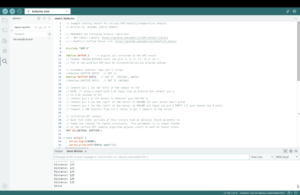
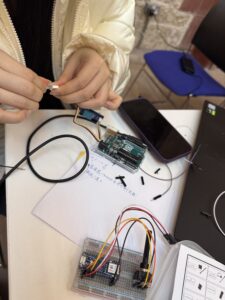
For future improvements, we need to further examine the code and sensor connections to ensure that the temperature data is read correctly.
And check the possible hardware or software problems to ensure the smooth completion of the experiment.
3. Arduino PIR Motion Sensor
Tester: Li Lyu, Can Huang
Test time: 2/6
Test material: Arduino PIR Motion Sensor, uno board
Test results:
In this test, we use the Arduino HC-SR501 PIR Sensor to connect with the Arduino UNO board and upload the code. When the code runs successfully, the serial monitor can normally detect data changes, and the HC-SR501 sensor can identify data changes when people move, and the function is basically normal, but in some cases, the sensor is not sensitive enough, and there is a delay or failure to detect in time.
Further adjustment of sensor parameters or the environment is required to improve the detection sensitivity.
